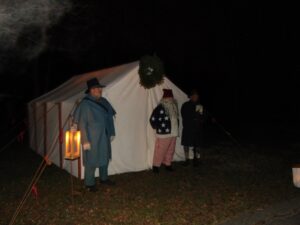Boone County Conservation District hosts annual 1800s Holiday Walk
By Anne Eickstadt
REPORTER
On Saturday, Dec. 3 the Boone County Conservation District hosted their annual 1800s Holiday Walk.
The 1800s Holiday Walk through the Roger D. Gustafson Nature Area began at 6 p.m. Luminaries lined the walkways to guide guests from one area to another.
Various groups of people, including Belvidere North High School carolers, walked the path in the chilly night air.
The walk included stops at a fur trapper tent, a Civil War field tent, a Civil War era Santa visiting with soldiers and a Newhouse Cabin with pioneer ladies, Jeannine Heck and April Parker, serving traditional Norwegian Christmas treats. These treats included pepparkakor (spice cookies), stolen (buttery, fruit bread), kringle (a flaky, iced pastry), and a hot fruit soup.
Also at the event was blacksmith, Lloyd Bellows, making nails.
“When they made nails in 1776, the blacksmith could make 600 nails in an hour,” Bellows said. “I was shoeing horses at age 15. In 1974, I went to a farrier school.”
He got away from blacksmithing for years, but, in 2007, he met a man who taught him to do “cool stuff.”
Today, Bellows is a farrier by trade.
“I am usually here for Pioneer Days, and I am here for the Holiday Walk.”
In the one room schoolhouse, the Kishwaukee Ramblers performed on stringed instruments. Guests perched on the school’s benches to enjoy the live music, while sipping hot chocolate and eating cakes and cookies.
Visitors could also enjoy freshly popped popcorn from a kettle over an open fire surrounded by hay bales where people could gather for warmth.
The one room Murray Cabin was packed with people as pioneer ladies described their rustic prairie Christmas preparation. Two ducks cooked as the ladies readied to go to Christmas Mass. The ducks were served with stuffing and bean soup.
The Christmas tree was not one of the tall fir, balsam, or spruce. It was cedar, because cedar is the only conifer evergreen tree which grows in this area.
Among the cedar Christmas tree’s hand-made ornaments were a spider and a pickle. Placing a pickle on the Christmas tree was a way to celebrate the harvest which would sustain the family until spring. The first glass ornament was a pickle. It was made of green glass to better hide it among the branches of the tree.
The first person to find the pickle on the tree was the first person to open their Christmas gift. Each person would only receive one gift because there was not enough money for more. A rich family might offer an extra, small prize to the person who found the pickle.
The tale of the spider was how people got the idea of putting garland on the tree. Spiders saw humans taking trees into their houses. This confused the spiders who hid in the trees. Once the humans were asleep, the spiders began their explorations at the top of the tree and made their way around and around the tree leaving a trail of webbing behind. The humans saw this webbing and liked the idea, so they put garland around the tree.
The walk ended back at the Nature Center where guests could make their own ornament as they warmed up.
For information on the 1800s Holiday Walk and future events, visit www.bccdil.org.



